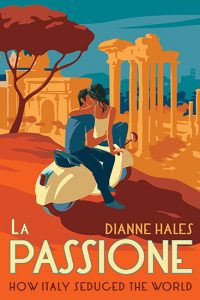St. Martin’s Summer in Italy
Long ago on a cold and rainy November 11, a former Roman soldier named Martino came across an old man stumbling and shivering on the road. Although he wanted to help, Martino had no money or blanket to offer. And so he took out his sword, slashed his cloak and gave half to the man. As Martino rode off with a joyful heart, the sun appeared through a break in the clouds, and the day grew warmer. That night Jesus appeared in Martin’s dream with half of the cloak in his hand and thanked him for his compassion. The warm days of early November –- known as Indian summer in the United States –- are called “l’estate di San Martino” (the summer of St. Martin) in Italy.
Italy’s “Day of the Dead”
Italy’s cimiteri (cemeteries) are coming alive this week as families prepare for November 2 (All Souls’ Day), which the Catholic church dedicates alla commemorazione dei defunti (to the commemoration of the deceased). To celebrate Il giorno dei morti (the Day of the Dead), many Italians travel to their home towns to place fiori, soprattutto crisantemi, e lumini (flowers, especially crysanthemums, and small lights) on the graves of departed relatives.
Italy’s Other Languages
For centuries the Italian peninsula was a patchwork of hundreds of dialects, often as different from one another as French from Spanish or English from Italian. Sailors from Genoa couldn’t understand—or be understood by—merchants from Venice or farmers from Friuli. Florentines living in il centro, the historic heart of the city, couldn’t speak the dialect of San Frediano on the other side of the Arno.
Honoring Dante during the Week of the Italian Language in the World
This year the Settimana della lingua italiana nel mondo (week of the Italian language in the world), from October 18 to 23, celebrates “Dante, l’Italiano.“ It is a fitting tribute during the 700th commemoration of the poet’s death in 1321.
Celebrating Italian American Heritage
Every October the United States celebrates Italian heritage month—with good reason. More than a mere country, Italy embodies a culture that has transformed art and architecture, language and music, food and fashion. Imagine painting without Leonardo. Sculpture without Michelangelo. Literature without Dante. No Verdi choruses or Puccini arias. No Fellini films, Ferrari roar, Valentino red. Tables bereft of pasta, pizza and a Sicilian cake so divine that its bakers swore it could make the dead breathe again.
A Passion for Olive Oil, Italy’s “Liquid Gold”
Olives have been cultivated throughout the Mediterranean for thousands of years, even before written language was invented. In Salento, the region in the far south “heel” of Italy’s boot, this “liquid gold” often comes from ancestral trees over 400 years old. I contend (without prejudice, of course) that we make the finest oil from the finest olive trees.
A Harvest of Italian Words
In Italy every season— la primavera (spring), l’estate (summer), l’autunno (autumn), l’inverno (winter) — has a different feel and focus. L’autunno is when farmers reap what they have sown.
The Joys of Italy’s Food
My relationship with Italy was sadly dysfunctional because of the food. When postal employees refused to sell me stamps because They. Must. Weigh. Each. Letter. Of. Each. Word. before I sealed the envelope, I was enraged. But all it took was a cup of cappuccino and I loved them again. A cloud of milk sprinkled with sugar and swirled into perfectly roasted coffee made every cup a short but memorable visit to heaven. Why be mad?
September in Italian
“Io sono Settembre” (I am September), a classic Italian filastrocca (children’s rhyme) begins. “Ai poverelli rifaccio le spese” (I do the grocery shopping for the poor) by leaving fruit on the trees, “bagno le botti” (I wash, or fill, the barrels) and “porto le mele, i fichi, l’uva ed ogni piacere” (I bring apples, figs, grapes and every pleasure). September is also the time for the vendemmia (grape harvest): Agosto prepara la cucina, settembre la cantina (August prepares the larder, September the wine cellar).
Summer in Italian: The Moon
One summer night on the island of Capri some friends told us to meet them at a popular restaurant at precisely 9:35 p.m. When we arrived at the bustling eatery, they escorted us away from the crowded main dining room to a quiet alcove and insisted that Bob and I take the two chairs looking toward the sea. As if on command, una luna rossa (a red moon) rose majestically from the sea to shine upon the faraglioni, the mammoth rock formations that heave out of the water like relics of a primeval ruin. Scientists explain this dazzling sight as un’illusione ottica (an optical illusion) that occurs when the moon is low on the horizon–the same reason that the sun may appear red as it sets into the horizon.







